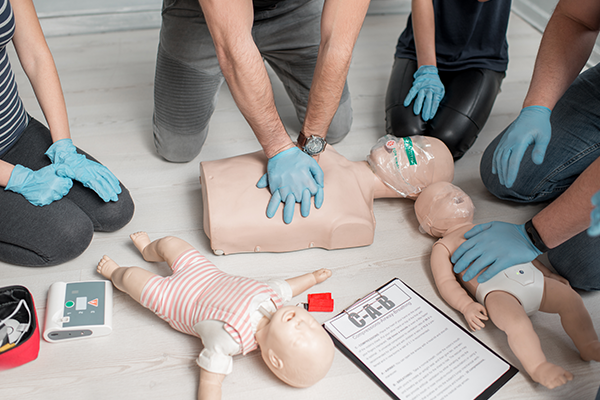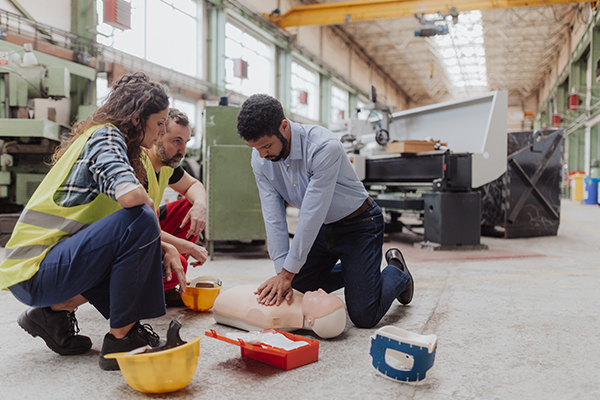Has it been a while since you undertook your first aid course? SafeWork Australia requires all workplace first aiders to renew their certification every three years. This article will explore the nuances of first aid training and guide you on how to renew your certificate. If you're interested in renewing or getting certified in first aid, read on.

What is first aid?
First aid is the first response to an illness or injury, where you either provide complete treatment or prevent a serious condition from worsening while waiting for professional medical help. A first aid certification, either personal or professional, equips you with the knowledge to assist in an emergency and could even save lives.
Learning first aid will teach you how to follow the DRSABCD action plan, which stands for:
- Danger - Assessing the situation and identifying any danger.
- Response - Checking if the person is conscious and breathing.
- Send for help - Contacting emergency services if there is no response.
- Airways - Placing the person in the recovery position and identifying and removing any airway obstructions.
- Breathing - Looking and listening for any signs of breathing.
- CPR - Performing cardiopulmonary resuscitation if breathing is not normal.
- Defibrillation - Using an automated defibrillator if available.
A first aid certification not only involves understanding basic medical care but also using situational skills, including:
- Action - Responding swiftly to a situation and reducing the chances of long-term damage.
- Reassurance - Understanding how to calm down others and reassure the injured person.
- Communication - Communicating clearly and calmly guiding others.
- Escalation - Assessing the situation and contacting emergency services when appropriate.
Some people get a first aid certification for personal reasons; however, first aid training is commonly acquired for workplace reasons.
First aid in the workplace
It’s important that we feel safe in the workplace and appropriate first aid measures are a large part of that. Depending on your workplace, the presence of an actual first aider is not always necessary; however, your employer must supply:
- First aid equipment accessible by each employee.
- Facilities for the administration of first aid.
- An adequate number of trained first aiders (where required).
Some examples of careers that typically require a first aid certification include disability support worker, aged care worker and teachers aides. Below is a table outlining the typical ratio of first aiders to general employees depending on the risk level of the workplace:
| Workplace risk level | Type of workplace | Ratio of first aiders to workers |
|---|---|---|
| Low-risk | Retail shops, offices, libraries or art galleries | 1:50 |
| High-risk | Factories, motor vehicle workshops or forestry operations | 1:25 |
| Remote high risk | All night convenience store and service station workers, long-distance freight transport drivers | 1:10 |
Source: SafeWork, NSW.
Additionally, acquiring a first-aid certificate can be a fantastic selling point when looking for employment, as it reduces the employers' need to fund training for new employees.
How long is a first aid certificate valid?
You are required to renew your first aid certificate every three years after being designated as a first aider in the workplace. Additionally, while personal first aid certifications do not legally require renewal, repeating your training offers many benefits.
Not only will it refresh your memory and improve your reaction speed, but it can also be important for keeping up-to-date with any medical innovations that may have occurred since your last course.
One notable example is the Heimlich manoeuvre. Introduced in the 1970s, the Heimlich manoeuvre was the go-to treatment for choking victims for a long time. However, in the early 2000s, the Heimlich manoeuvre was replaced by a different manoeuvre—back slaps and chest thrusts. This was due to studies showing that the Heimlich manoeuvre caused more harm than good, risking damage to the gastrointestinal tract and abdominal aorta.
For quick reference, below is a table detailing the renewal timeline for the most common first aid certifications:
| Certification name | How often should you renew? |
|---|---|
Provide Cardiopulmonary Resuscitation (CPR) | Annually. |
Provide First Aid | At least every three years with a CPR refresher completed annually. |
| Provide First Aid in an Education and Care Setting | At least every three years with a CPR refresher completed annually. |
How to get a new first aid certificate
Fortunately, acquiring a fresh first aid certificate is as easy as completing a Provide First Aid course at TAFE Gippsland. We offer two first aid courses:
- Provide First Aid - This short course will teach you skills in first aid response, life support and the management of casualties, incidents and first aid.
- Provide First Aid (1 day online & 1 day in class) - This short course offers the same learning goals as the traditional Provide First Aid course but is delivered flexibly through a combination of online and on-campus workshops.
It is important to note that both of these courses require some physical ability, especially when completing the CPR component. If you do not have any issues kneeling or maneuvering a CPR manikin, you should be able to complete the course.
If you’re only seeking a CPR refresher, you can complete the Provide CPR short course, which trains you to deliver high-quality CPR per Australian Resuscitation Council guidelines. Like both first aid short courses, this course requires a level of physical ability.

How long does a first aid course take?
If you’re looking at completing a first aid course at TAFE Gippsland, you can expect to dedicate two eight-hour days to both the Provide First Aid and Provide First Aid (1 day online & 1 day in class) courses.
What are the assessment principles of first aid?
The key assessment principles for first aid, known as the three Ps, are:
- Preserve life - Performing a risk assessment and identifying any danger in the area is the first step in first aid. You should never put your life in danger; however, if safely able, you should remove the injured person from harm’s way.
- Prevent deterioration - Once you have taken the steps required to protect everyone on the scene, you should aim to prevent the deterioration of the injured person’s condition.
- Promote recovery - Finally, you should provide any treatment that can promote faster recovery and reduce the chance of long-term complications.
In Australia, we have one of the lowest first aid rates, with less than five per cent of Australians trained in first aid in 2017. Having a first aid certification is not only beneficial for employability and workplace first aid requirements but can also save lives. Simply knowing and administering CPR to someone whose heart has stopped within the first minute can improve their chance of survival by 80 per cent.
Getting a first aid certification will give you the ability to confidently apply first aid. And if you’re renewing your certificate, it could give you the up-to-date tools to save lives and minimise long-term damage. Make the world safer today with a first aid certification at TAFE Gippsland.